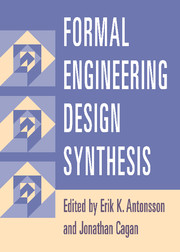Book contents
- Frontmatter
- Contents
- Contributing Authors
- Foreword
- Preface
- Introduction
- 1 Vitruvius Redux
- 2 How to Calculate with Shapes
- 3 Engineering Shape Grammars
- 4 Creating Structural Configurations
- 5 Microsystem Design Synthesis
- 6 Function-Based Synthesis Methods in Engineering Design
- 7 Artificial Intelligence for Design
- 8 Evolutionary and Adaptive Synthesis Methods
- 9 Kinematic Synthesis
- 10 Systematic Chemical Process Synthesis
- 11 Synthesis of Analog and Mixed-Signal Integrated Electronic Circuits
- 12 Mechanical Design Compilers
- 13 Scientific Discovery and Inventive Engineering Design
- Index
8 - Evolutionary and Adaptive Synthesis Methods
Published online by Cambridge University Press: 10 October 2009
- Frontmatter
- Contents
- Contributing Authors
- Foreword
- Preface
- Introduction
- 1 Vitruvius Redux
- 2 How to Calculate with Shapes
- 3 Engineering Shape Grammars
- 4 Creating Structural Configurations
- 5 Microsystem Design Synthesis
- 6 Function-Based Synthesis Methods in Engineering Design
- 7 Artificial Intelligence for Design
- 8 Evolutionary and Adaptive Synthesis Methods
- 9 Kinematic Synthesis
- 10 Systematic Chemical Process Synthesis
- 11 Synthesis of Analog and Mixed-Signal Integrated Electronic Circuits
- 12 Mechanical Design Compilers
- 13 Scientific Discovery and Inventive Engineering Design
- Index
Summary
The simplest scheme of evolution is one that depends on two processes; a generator and a test. The task of the generator is to produce variety, new forms that have not existed previously, whereas the task of the test is to cull out the newly generated forms so that only those that are well fitted to the environment will survive.
— Herbert A. Simon, The Sciences of the Artificial, 1969, MIT PressINTRODUCTION
The synthesis of novel engineering designs can take on the character of an exploration, especially when the exploration has the capability to experiment, either in a random or directed manner, not simply with the values of parameters that describe a single design configuration, but with a wide range of different configurations.
Since the 1960s, there has been an increasing interest in simulating the natural evolutionary process to solve optimization problems, leading to the development of adaptive and stochastic exploration techniques (Fogel, 1962, 1994, 1998; Holland, 1962; Rechenberg, 1965; Schwefel, 1965; Goldberg, 1989; Hammel, Bäck, and Schwefel, 1997) that can often outperform conventional optimization methods when applied to challenging real-world problems. Evolutionary and adaptive search methods, such as genetic algorithms and simulated annealing, stochastically refine or alter individual candidate solutions in a population, evaluate the fitness or performance of these new candidates, and keep only those with good fitness values for the next iteration.
- Type
- Chapter
- Information
- Formal Engineering Design Synthesis , pp. 270 - 320Publisher: Cambridge University PressPrint publication year: 2001
- 2
- Cited by



